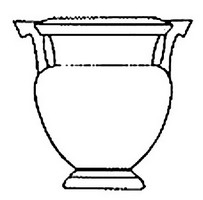Krater

The term 'krater' suggests a mixing-vessel - compare Greek kerannumi - to mix, and we know that the wine served at the symposium was mixed with water. In the Athenian repertoire, there are four main types identified today: column-, calyx-, bell- and volute-.

Named for its column-like handles, the column-krater is first known from Corinthian examples dated to the late seventh century B.C.. It is regularly produced by Athenian potters from the first half of the sixth-century until the third quarter of the fifth century B.C.
 BR>
The handles of the calyx-krater are placed low down on the body, at what is termed the cul. Their upward curling form lends the shape an appearance reminiscent of the calyx of a flower, hence the name. The earliest known example was possibly made by Exekias in the third quarter of the sixth century. It continues to be produced, mainly in red-figure, becoming more elongated over the course of the fifth and fourth centuries.
BR>
The handles of the calyx-krater are placed low down on the body, at what is termed the cul. Their upward curling form lends the shape an appearance reminiscent of the calyx of a flower, hence the name. The earliest known example was possibly made by Exekias in the third quarter of the sixth century. It continues to be produced, mainly in red-figure, becoming more elongated over the course of the fifth and fourth centuries.

The bell-krater first occurs in the early fifth century, and is not found decorated in black-figure. It is named for its bell-like shape, perhaps originating in wood. It has small horizontal upturned handles just over halfway up the body. Some do not have a foot, and earlier examples may have lugs for handles. Over the course of the fifth and fourth centuries, the shape becomes slimmer.

The volute-krater is named after its handles. The Françl;ois Vase is a famous and early example, but the typical Athenian form occurs only later in the sixth century, with the handles tightly curled so that they look like the volutes on Ionic columns. The shape is also found in metal. Over the course of the fifth and fourth centuries, examples become slimmer, and Apulian volute-kraters from South Italy are particularly elaborate.





